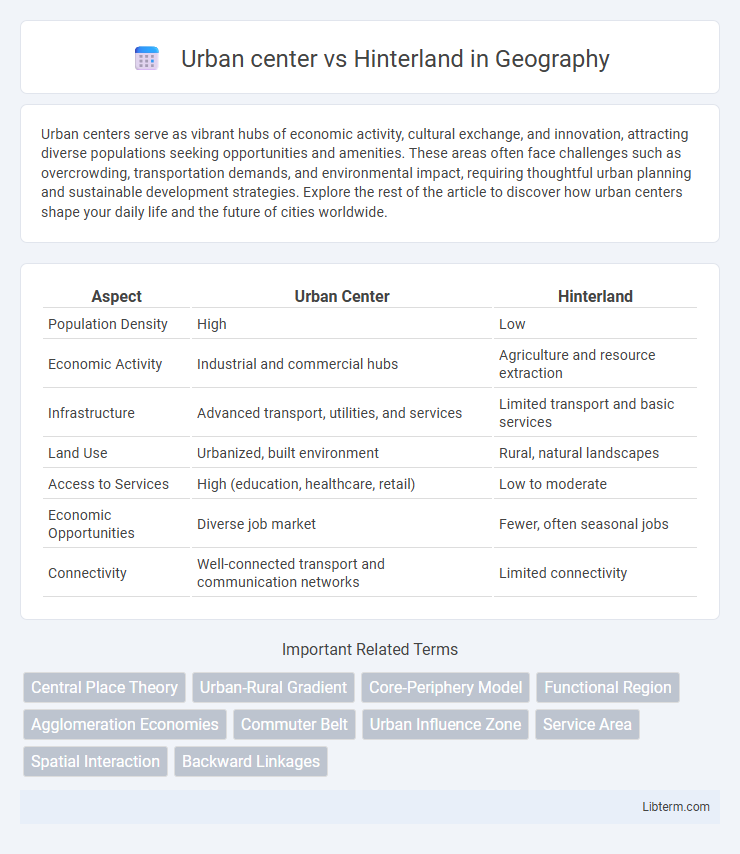Urban centers serve as vibrant hubs of economic activity, cultural exchange, and innovation, attracting diverse populations seeking opportunities and amenities. These areas often face challenges such as overcrowding, transportation demands, and environmental impact, requiring thoughtful urban planning and sustainable development strategies. Explore the rest of the article to discover how urban centers shape your daily life and the future of cities worldwide.
Table of Comparison
| Aspect | Urban Center | Hinterland |
|---|---|---|
| Population Density | High | Low |
| Economic Activity | Industrial and commercial hubs | Agriculture and resource extraction |
| Infrastructure | Advanced transport, utilities, and services | Limited transport and basic services |
| Land Use | Urbanized, built environment | Rural, natural landscapes |
| Access to Services | High (education, healthcare, retail) | Low to moderate |
| Economic Opportunities | Diverse job market | Fewer, often seasonal jobs |
| Connectivity | Well-connected transport and communication networks | Limited connectivity |
Definition of Urban Center and Hinterland
An urban center is a densely populated area characterized by significant infrastructure, commercial activities, and concentrated services, serving as a focal point for economic, social, and cultural interactions. Hinterland refers to the surrounding rural or less developed region that relies on the urban center for access to markets, resources, and administrative functions. The dynamic relationship between urban centers and their hinterlands is crucial for regional development and spatial organization.
Historical Development of Urban Centers
Historical development of urban centers often stems from strategic geographic locations such as riverbanks, trade routes, or resource-rich areas, which facilitated economic growth and population concentration. Urban centers became hubs of political power, commerce, and cultural exchange, leading to infrastructure advancements and social stratification that distinguished them from the surrounding hinterland. The hinterland's role in supplying raw materials and agricultural products was essential for sustaining urban populations and supporting their expanding economies.
Economic Roles: Urban Centers vs. Hinterlands
Urban centers serve as hubs of economic activity, concentrating industries, services, and financial institutions that drive regional growth and innovation. Hinterlands provide essential resources such as agriculture, raw materials, and labor, supporting urban economies by supplying inputs and markets for goods. The symbiotic relationship between urban centers and hinterlands underpins the efficiency and sustainability of regional economic systems.
Population Density and Demographics Comparison
Urban centers typically exhibit significantly higher population densities, often exceeding several thousand persons per square kilometer, reflecting concentrated residential and commercial activity. In contrast, hinterlands maintain lower population densities, frequently below 100 persons per square kilometer, characterized by dispersed settlements and agricultural land use. Demographically, urban centers tend to have more diverse and younger populations due to migration and economic opportunities, while hinterlands often feature older, more homogeneous populations with slower growth rates.
Infrastructure and Accessibility Differences
Urban centers feature highly developed infrastructure including extensive road networks, public transportation systems, and advanced utilities, facilitating efficient accessibility for residents and businesses. Hinterlands typically have limited infrastructure, with fewer paved roads, less frequent public transit, and constrained access to essential services, creating barriers to mobility and economic integration. This disparity in infrastructure and accessibility influences economic activity, resource distribution, and quality of life between urban centers and their surrounding rural hinterlands.
Social and Cultural Dynamics
Urban centers serve as vibrant hubs of social interaction and cultural exchange, fostering diverse communities and dynamic cultural institutions such as museums, theaters, and art galleries. Hinterlands often maintain traditional social structures and cultural practices rooted in agriculture and local heritage, reflecting slower social change and stronger kinship ties. The interaction between urban centers and hinterlands influences regional identity, where urban innovation meets rural tradition, shaping social cohesion and cultural evolution.
Resource Distribution and Utilization
Urban centers concentrate resources such as capital, technology, and skilled labor, driving high levels of productivity and economic diversification. Hinterlands typically provide raw materials, agricultural products, and natural resources, which are transported to urban centers for processing and consumption. Efficient infrastructure and trade linkages between urban centers and hinterlands optimize resource distribution and utilization, enhancing regional economic integration and development.
Urban-Rural Migration Patterns
Urban centers attract significant migration due to better employment opportunities, healthcare, and education compared to hinterlands, which remain predominantly agricultural and less developed. Migration patterns often result in urban population growth while rural areas experience depopulation and labor shortages. This demographic shift influences economic development, infrastructure demands, and social services distribution between urban and rural regions.
Environmental Impacts of Urbanization
Urban centers generate significant environmental impacts including increased air and water pollution, habitat loss, and higher carbon emissions due to dense population and industrial activities. Hinterlands often experience resource depletion and ecosystem disruption as urban demand drives deforestation, mining, and agricultural expansion to supply food and raw materials. The spatial interaction between urban centers and hinterlands intensifies environmental degradation, necessitating sustainable land-use planning and conservation strategies.
Future Trends in Urban-Hinterland Relationships
Future trends in urban-hinterland relationships emphasize increased integration through advanced transportation networks and digital connectivity, enabling seamless resource and information exchange. Smart city developments will drive demand for sustainable rural contributions, promoting ecological agriculture and renewable energy sourcing from hinterlands. Emerging policies prioritize balanced regional growth, reducing urban congestion while enhancing hinterland economic resilience and infrastructure modernization.
Urban center Infographic

 libterm.com
libterm.com